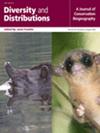Genomic Assessment of Australian White Sharks (Carcharodon carcharias) Challenges Previous Evidence of Population Subdivision
Abstract
Aim
The white shark (Carcharodon carcharias) is one of the world's largest and most recognisable marine predators but has suffered significant declines since the mid-twentieth century. Conservation efforts remain complicated by persistent knowledge gaps associated with white shark biology and ecology, including the biological connectedness of white shark populations. We re-assess patterns of population genetic structure in Australian white sharks, where two subpopulations—eastern and southern-western—are currently recognised based on previous animal tracking and genetic assessments.
Methods
Population genomic analyses are performed using tissues from ~650 individual white sharks and ~7000 single nucleotide polymorphism (SNP) loci generated through reduced genome representation sequencing. We test for evidence of genetic structure and relatedness among sharks from eastern and southern Australia and use population genetic simulations to assess the likely strength of inter-generational migration between regions.
Results
This study challenges the current paradigm of population structure in Australian white sharks, showing a lack of genetic structure between white sharks from eastern and southern Australia. These findings are further supported by population genetic simulations and kinship analyses indicating high levels of intergenerational migration and relatedness between regions. Consistent with recent reports from eastern Australia, we also detected high levels of relatedness among juvenile and subadult white sharks and estimated the overall effective population size (Ne) of Australian white sharks to be less than 500 individuals. Furthermore, we provide evidence of a potential reduction in Ne over the last two generations.
Main Conclusions
Overall, these findings highlight the need to consider this revised estimate of genetic structure when discussing the management and conservation of the species. Our results also raise concerns for the conservation of Australian white sharks highlighting risks of potential inbreeding, and reductions in population fitness and resilience. We discuss the need for further research and the importance of ongoing population monitoring.


 求助内容:
求助内容: 应助结果提醒方式:
应助结果提醒方式:


